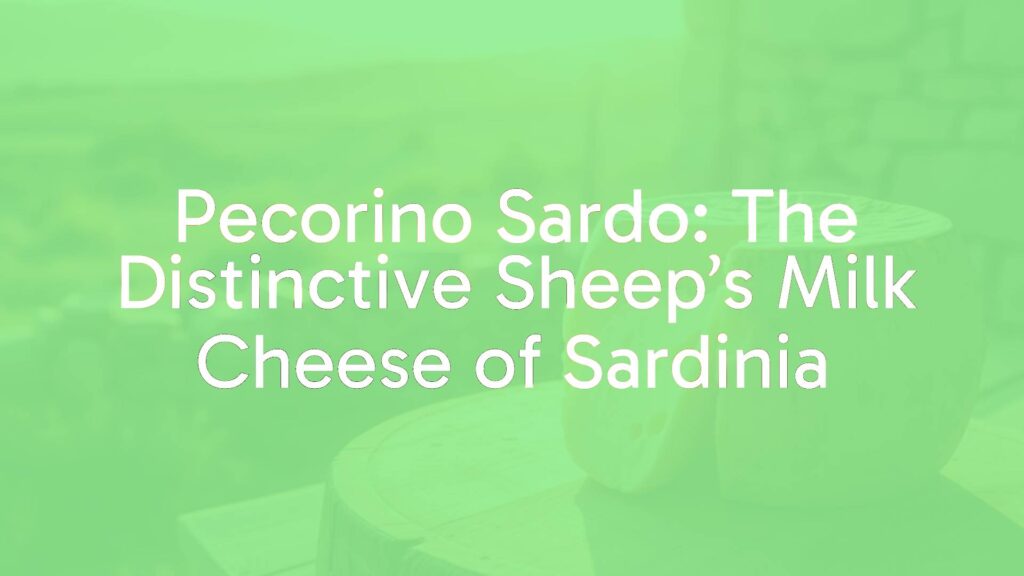An Introduction to Pecorino Sardo
Pecorino Sardo is a traditional Italian cheese originating from the island of Sardinia. Made exclusively from the milk of local sheep, this cheese is renowned for its robust flavor and characteristic texture. Unlike its more famous cousin, Pecorino Romano, Pecorino Sardo exhibits a softer, milder profile, with regional nuances shaped by Sardinia’s unique pastures and cheesemaking heritage.
What Makes Pecorino Sardo Unique?
The distinctiveness of Pecorino Sardo arises from its exclusive use of whole sheep’s milk and the influence of Sardinia’s diverse landscapes. The cheese varies in intensity depending on its age, ranging from delicate and slightly sweet when young (“dolce”) to firm, crumbly, and piquant when matured (“maturo”). Recognized with Protected Designation of Origin (PDO) status, each wheel is crafted according to time-honored local methods, resulting in a strikingly authentic taste experience.
Historical Roots and Cultural Context
Pecorino Sardo’s history stretches back centuries, with roots firmly embedded in Sardinia’s agrarian traditions. Sheep farming has long been integral to the island’s way of life, fostering a symbiotic relationship between the land and its people. The cheese reflects this deep cultural connection and is commonly featured at Sardinian celebrations and gatherings, embodying hospitality and regional pride.
Traditional Production Practices
Pecorino Sardo is produced using fresh sheep’s milk collected exclusively from Sardinian flocks. The milk is curdled with either rennet or natural enzymes, then pressed and salted. Each wheel is typically aged on wooden shelves in cool, ventilated cellars for periods ranging from a few weeks to over six months. Younger cheeses are creamier and more elastic, while mature varieties become compact and aromatic, developing a pale straw to light brown rind.
Varieties and Aging
There are two main styles of Pecorino Sardo:
- Pecorino Sardo Dolce – Aged for 20–60 days, this style is mild, soft, and slightly tangy, making it ideal for appetizers or slicing.
- Pecorino Sardo Maturo – Matured for over two months, it boasts a firmer texture with deeper, more savory notes perfect for grating or bold pairings.
Classic Pairings and Enjoyment
Pecorino Sardo is versatile at the table. The younger “dolce” type pairs well with crisp white wines, fresh fruits, and rustic bread, while the mature “maturo” shines alongside robust reds, cured meats, and honey. Traditionally, it is enjoyed as part of a Sardinian antipasto platter, grated over hearty pasta dishes, or served with seasonal vegetables. Its balanced saltiness and depth make it a favorite in both everyday meals and festive occasions.
Serving Suggestions and Tips
To fully appreciate Pecorino Sardo’s character, serve it at room temperature, allowing its aroma and texture to emerge. For an authentic Sardinian touch, drizzle mature Pecorino Sardo with local chestnut honey or enjoy it with pane carasau—a crisp flatbread native to the island. When used as a grating cheese, Pecorino Sardo maturo is an excellent alternative to more pungent varieties, lending complexity without overpowering other ingredients.
Cultural Significance and Modern Appeal
Pecorino Sardo is deeply woven into Sardinia’s culinary identity, valued both as an everyday staple and as a symbol of regional craftsmanship. Its distinctive flavor, rooted in the landscape and traditions of Sardinia, ensures it remains cherished by locals and increasingly appreciated by cheese lovers worldwide. Whether savored solo or incorporated into classic recipes, Pecorino Sardo offers a true taste of Sardinian heritage.

